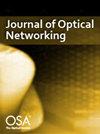Survivable broadband local access PON architecture: a new direction for supporting simple and efficient resilience capabilities
引用次数: 1
Abstract
This work proposes a two-fiber self-healing ring-based local access passive optical network (PON) architecture that addresses some of the limitations of current tree-based PON architectures including supporting private networking capability as well as providing simple and cost-effective fully distributed resilience capabilities against most kinds of networking failures. Specifically, this work proposes and devises a simple self-healing Ethernet PON architecture that supports a truly shared LAN capability among end users. The main characteristic of the proposed architecture is that it supports a fully distributed control plane among the optical network units (ONUs) for ONU-to-ONU communication. The control plane supports fully distributed fault detection and recovery mechanisms as well as a decentralized dynamic bandwidth allocation scheme in which the optical line terminator is excluded from both the bandwidth arbitration and fault detection and recovery processes. The proposed decentralized automatic protection switching technique is capable of protecting against both node (ONU) and fiber failures (distribution and trunk) through active participation of ONUs. This scheme enables the recovery of all network traffic including upstream, downstream, and LAN data. In addition, the proposed protection technique can protect against any combination of concurrent double failures including trunk and distribution fiber breaks and node failures.可生存的宽带本地接入PON架构:支持简单高效的弹性能力的新方向
这项工作提出了一种基于双光纤自修复环的本地接入无源光网络(PON)架构,该架构解决了当前基于树的PON架构的一些局限性,包括支持专用网络功能以及针对大多数网络故障提供简单且具有成本效益的完全分布式弹性功能。具体来说,这项工作提出并设计了一个简单的自修复以太网PON架构,该架构支持最终用户之间真正共享的局域网功能。该架构的主要特点是在光网络单元(onu)之间支持一个完全分布式的控制平面,用于onu对onu通信。控制平面支持全分布式的故障检测和恢复机制,支持分散的动态带宽分配方案,将光线终止器排除在带宽仲裁和故障检测和恢复过程之外。所提出的分散自动保护交换技术能够通过节点(ONU)和光纤(分布和中继)的积极参与来防止节点(ONU)和光纤故障的发生。该方案可以恢复所有网络流量,包括上行、下行和局域网数据。此外,所提出的保护技术可以防止任何并发双重故障的组合,包括干线和分布光纤中断和节点故障。
本文章由计算机程序翻译,如有差异,请以英文原文为准。
求助全文
约1分钟内获得全文
求助全文

 求助内容:
求助内容: 应助结果提醒方式:
应助结果提醒方式:


